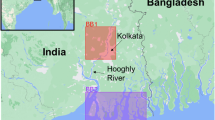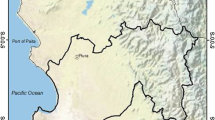Abstract
Cholera, an acute diarrheal illness, is caused by infection of the intestine with the bacterium Vibrio cholerae after ingestion of contaminated water or food. The disease had disappeared from most of the developed countries in the last 50 years, but cholera epidemics remain a major public health problem in many developing countries, most often localized in tropical areas. Cholera is an infectious disease for which a relationship between disease temporal patterns and climate has been demonstrated, but only in an endemic context and for local areas of Asia and South America. Until now, similar studies have not been done in an epidemic context, on the African continent, although the largest number of cholera cases has been reported for those countries by the World Health Organization. The wavelet method was used in order to explore periodicity in (i) a long-time monthly cholera incidence in Ghana, West Africa, (ii) proxy environmental variables, and (iii) climatic indices time series, from 1975 to 1995. Cross-analysis were done to explore links between these time series, i.e., between cholera and climate. Results showed strong statistical association (coherency) from the end of the 1980s, between cholera outbreak resurgences in Ghana and the climatic/environmental parameters under scrutiny. Further examination of the existence of common spatial and temporal patterns in infectious diseases on the continent of Africa will permit development of more effective treatment of disease.



Similar content being viewed by others
References
Ali M, Emch M, Donnay JP, Yunus M, Sack RB (2002) The spatial epidemiology of cholera in an endemic area of Bangladesh. Social Science & Medicine 55:1015–1024
Bouma MJ, Pascual M (2001) Seasonal and interannual cycles of endemic cholera in Bengal 1891–1940 in relation to climate and geography. Hydrobiologia 460:147–156
Broutin H, Guégan J-F, Elguero E, Simondon F, Cazelles B (2005) Large-scale comparative analysis of pertussis population dynamics: periodicity, synchrony, and impact of vaccination. American Journal of Epidemiology 161:1159–1167
Cazelles B, Chavez M, McMichael AJ, Hales S (2005) Nonstationary influence of El Nino on the synchronous dengue epidemics in Thailand. PLoS Medicine 2:e106
Cazelles B, Stone L (2003) Detection of imperfect population synchrony in an uncertain world. Journal of Animal Ecology 72:953–968
Chatfield C (2004) The Analysis of Time Series: an Introduction, 6th ed., Boca Raton, FL: Chapman & Hall/CRC
Checkley W, Epstein LD, Gilman RH, Figueroa D, Cama RI, Patz JA, et al. (2000) Effect of El Nino and ambient temperature on hospital admissions for diarrhoeal diseases in Peruvian children. Lancet 355:442–450
Colwell RR (1996) Global climate and infectious disease: the cholera paradigm. Science 274:2025–2031
Colwell RR, Huq A (2001) Marine ecosystems and cholera. Hydrobiologia 460:141–145
Colwell RR, Huq A, Islam MS, Aziz KM, Yunus M, Khan NH, et al. (2003) Reduction of cholera in Bangladeshi villages by simple filtration. Proceedings of the National Academy of Sciences of the United States of America 100(3):1051–1055
Epstein PR (1993) Algal blooms in the spread and persistence of cholera. Biosystems 31:209–221
Faruque SM, Albert MJ, Mekalanos JJ (1998) Epidemiology, genetics, and ecology of toxigenic Vibrio cholerae. Microbiology and Molecular Biology Reviews 62:1301–1314
Faruque SM, Naser IB, Islam MJ, Faruque AS, Ghosh AN, Nair GB, et al. (2005) Seasonal epidemics of cholera inversely correlate with the prevalence of environmental cholera phages. Proceedings of the National Academy of Sciences of the United States of America 102:1702–1707
Grenfell BT, Bjornstad ON, Kappey J (2001) Travelling waves and spatial hierarchies in measles epidemics. Nature 414:716–723
Islam MS, Drasar BS, Bradley DJ (1990). Long-term persistence of toxigenic Vibrio cholerae 01 in the mucilaginous sheath of a blue-green alga, Anabaena variabilis. Journal of Tropical Medicine and Hygiene 93:133–139
Islam MS, Drasar BS, Sack RB (1994) The aquatic flora and fauna as reservoirs of Vibrio cholerae: a review. Journal of Diarrhoeal Diseases Research 12:87–96
Islam MS, Rahim Z, Alam MJ, Begum S, Moniruzzaman SM, Umeda A, et al. (1999) Association of Vibrio cholerae O1 with the cyanobacterium, Anabaena sp., elucidated by polymerase chain reaction and transmission electron microscopy. Transactions of Royal Society of Tropical Medicine and Hygiene 93:36–40
Kelley L (2001). The global dimension of cholera. Global Change & Human Health 2:6–17
Koelle K, Pascual M, Yunus M (2005a) Pathogen adaptation to seasonal forcing, climate change. Proceedings of the Royal Society of London. Series B: Biological Sciences 272:971–977
Koelle K, Rodo X, Pascual M, Yunus M, Mostafa G (2005b) Refractory periods and climate forcing in cholera dynamics. Nature 436:696–700
Lipp EK, Huq A, Colwell RR (2002) Effects of global climate on infectious disease: the cholera model. Clinical Microbiology Reviews 15:757–770
Lobitz B, Beck L, Huq A, Wood B, Fuchs G, Faruque AS, et al. (2000) Climate and infectious disease: use of remote sensing for detection of Vibrio cholerae by indirect measurement. Proceedings of the National Academy of Sciences of the United States of America 97:1438–1443
Marsac F (2001) Climate and oceanographic indices appraising the environmental fluctuations in the Indian Ocean. Indian Ocean Tuna Commission Proceedings 4:293–301
Marsac F, Le Blanc JL (1998) Interannual and ENSO-associated variability of the coupled ocean-atmosphere system with possible impacts on the yellowfin tuna fisheries of the Indian and Atlantic oceans. International Commission for the Conservation of Atlantic Tunas Collective Volume of Scientific Papers 50:345–377
Miller CJ, Drasar BS, Feachem RG (1982) Cholera and estuarine salinity in Calcutta and London. Lancet 1:1216–1218
Montilla R, Chowdhury MA, Huq A, Xu B, Colwell RR (1996) Serogroup conversion of Vibrio cholerae non-O1 to Vibrio cholerae O1: effect of growth state of cells, temperature, and salinity. Canadian Journal of Microbiology 42:87–93
Pascual M, Bouma MJ, Dobson AP (2002) Cholera and climate: revisiting the quantitative evidence. Microbes and Infection 4:237–245
Pascual M, Rodo X, Ellner SP, Colwell R, Bouma MJ (2000) Cholera dynamics and El Nino-Southern Oscillation. Science 289:1766–1769
Piarroux R, Bompangue D (2006) Needs for an integrative approach of epidemics: the example of cholera. In: Encyclopedia of Infectious Diseases: Modern Methodologies, Tibayrenc M (editor), Chichester, UK: John Wiley & Sons Ltd (In press)
Rodo X, Pascual M, Fuchs G, Faruque AS (2002) ENSO and cholera: a nonstationary link related to climate change? Proceedings of the National Academy of Sciences of the United States of America 99:12901–12906
Salazar-Lindo E, Pinell-Salles P, Maruy A, Chea-Woo E (1997). El Nino and diarrhoea and dehydration in Lima, Peru. Lancet 350:1597–1598
Simanjuntak CH, Larasati W, Arjoso S, Putri M, Lesmana M, Oyofo BA, et al. (2001) Cholera in Indonesia in 1993–1999. American Journal of Tropical Medicine and Hygiene 65:788–797
Smith KF, Dobson AP, McKenzie FE, Real LA, Smith DL, Wilson ML (2005) Ecological theory to enhance infectious disease control and public health policy. Frontiers in Ecology and the Environment 3:29–37
Speelmon EC, Checkley W, Gilman RH, Patz J, Calderon M, Manga S (2000) Cholera incidence and El Nino-related higher ambient temperature. JAMA 283:3072–3074
Tamplin ML, Gauzens AL, Huq A, Sack DA, Colwell RR (1990) Attachment of Vibrio cholerae serogroup O1 to zooplankton and phytoplankton of Bangladesh waters. Applied Environmental Microbiology 56:1977–1980
Torrence C, Compo GP (1998) A practical guide to wavelet analysis. Bulletin of the American Meteorological Society 79:61–78
UNEP (2005) Emerging challenges—new findings. In: Geo Year Book 2004–2005: an Overview of Our Changing Environment, New York: United Nations Publications, pp 71–79
World Health Organization (2005) Cholera, 2004. Weekly Epidemiological Record 80:261–268
Xu H-S (1982) Survival and viability of non-culturable Escherichia coli and Vibrio cholerae in the estuarine and marine environment. Microbial Ecology 8:313–323
Acknowledgments
This work was supported by a “Gestion et Impacts du Changement Climatique” grant (CHOLCLIM) from the French Ministry of Ecology and Sustainable Resources (FMESR). G.C.M. thanks the French authorities and the Centre National d’Etudes Spatiales (CNES) for PhD fellowships. B.C. is supported by the University Pierre & Marie Curie, Paris VI. J-F.G. thanks both the Institut de Recherche pour le Développement (IRD) and the Centre National de la Recherche Scientifique (CNRS).
Author information
Authors and Affiliations
Corresponding author
Rights and permissions
About this article
Cite this article
Constantin de Magny, G., Cazelles, B. & Guégan, JF. Cholera Threat to Humans in Ghana Is Influenced by Both Global and Regional Climatic Variability. EcoHealth 3, 223–231 (2006). https://doi.org/10.1007/s10393-006-0061-5
Published:
Issue Date:
DOI: https://doi.org/10.1007/s10393-006-0061-5




